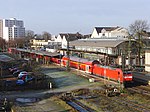Battle of Sievershausen
1553 in the Holy Roman EmpireBattles in Lower SaxonyBattles involving SaxonyConflicts in 1553

The Battle of Sievershausen occurred on 9 July 1553 near the village of Sievershausen (today part of Lehrte in present-day Germany), where the forces of the Hohenzollern margrave Albert Alcibiades of Brandenburg-Kulmbach fought against the united troops of Elector Maurice of Saxony and Duke Henry V of Brunswick-Wolfenbüttel. With 4,000 men killed, including the Saxon elector and two of Henry's sons, it was one of the bloodiest battles on Lower Saxon territory. Margrave Albert was defeated.
Excerpt from the Wikipedia article Battle of Sievershausen (License: CC BY-SA 3.0, Authors, Images).Battle of Sievershausen
L 412,
Geographical coordinates (GPS) Address Nearby Places Show on map
Geographical coordinates (GPS)
| Latitude | Longitude |
|---|---|
| N 52.375833333333 ° | E 10.112777777778 ° |
Address
L 412
31275 (Arpke)
Lower Saxony, Germany
Open on Google Maps






